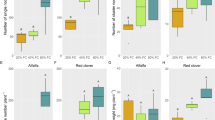Abstract
This study examines the adaptive role of not resorbing N in N2-fixing deciduous trees in terms of their energy balance. The autumnal growth of N2-fixing Alnus firma Sieb. et Zucc. (alder) was compared with that of the non-N2-fixing Morus bombycis Koizumi (mulberry), which resorbs leaf N. The freezing resistance of leaves of both species was −2°C. Mulberry seedlings lost their photosynthetic ability in mid-October, although the minimum temperature was still above 0°C. Thereafter, their leaves turned yellow and were gradually shed. In contrast, seedlings of the alder maintained their photosynthetic ability until mid-November, when the minimum temperature fell to the freezing resistance limit. Thereafter, their leaves were shed quickly without an autumn tint. The mulberry resorbed 48.9% of leaf N, whereas the alder resorbed hardly any. These results show that, compared with the mulberry tree, the alder extended its growth period for 1 month in return for losing leaf N without resorption. The amount of energy assimilated by the alder in the extended growth period was about six times that required for compensating for the nitrogen loss, if the compensation is dependent only on the tree's own nitrogen fixation. This surplus energy balance has probably allowed N2-fixing deciduous trees to evolve their non-N-resorbing trait.



Similar content being viewed by others
References
Aerts R (1996) Nutrient resorption from senescing leaves of perennials: are there general patterns? J Ecol 84:597–608
AOAC (1984) Official method of analysis, 14th edn. AOAC, Arlington, Va.
Cote B, Vogel CS, Dawson JO (1989) Autumnal changes in tissue nitrogen of autumn olive, black alder and eastern cottonwood. Plant Soil 118:23–32
Finke RL, Harper JE, Hageman RH (1982) Efficiency of nitrogen assimilation by N2-fixing and nitrate-grown soybean plants [Glycine max (L.) Merr.] Plant Physiol 70:1178–1184
Killingbeck KT (1993) Inefficient nitrogen resorption in genets of the actinorhizal nitrogen fixing shrub Comptonia peregrina: physiological ineptitude or evolutionary tradeoff? Oecologia 94:542–549
Killingbeck KT (1996) Nutrient in senesced leaves: keys to the search for potential resorption and resorption proficiency. Ecology 77:1716–1727
May J D, Killingbeck KT (1992) Effects of preventing nutrient resorption on plant fitness and foliar nutrient dynamics. Ecology 73:1868–1878
Rodriguez-Barrueco C, Miguel C, Subramaniam P (1984) Seasonal fluctuations of the mineral concentration of alder [Alnus flutinosa (L.) Gaertn.] from the field. Plant Soil 78:201–208
Sakai A (1980) Winter hardiness of tree species at high altitudes in the east Himalaya, Nepal. Ecology 62:1288–1298
Stachurski A., Zimka JR (1975) Methods of studying forest ecosystems: leaf area, leaf production and withdrawal of nutrients from leaves of trees. Ekol Pol 23:637–68
Swift MJ, Heal OW, Anderson JM (1979) Decomposition in terrestrial ecosystems. Blackwell, Oxford
Acknowledgements
The author thanks Dr. F. S. Chapin III, Dr. H. Nagashima, Y. Osone, H. Taneda, and anonymous reviewers for helpful advice and useful discussions. We also thank H. Takahashi for his technical assistance.
Author information
Authors and Affiliations
Corresponding author
Rights and permissions
About this article
Cite this article
Tateno, M. Benefit to N2-fixing alder of extending growth period at the cost of leaf nitrogen loss without resorption. Oecologia 137, 338–343 (2003). https://doi.org/10.1007/s00442-003-1357-6
Received:
Accepted:
Published:
Issue Date:
DOI: https://doi.org/10.1007/s00442-003-1357-6




